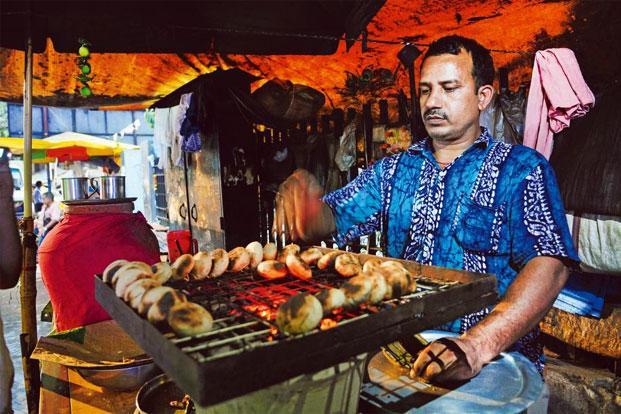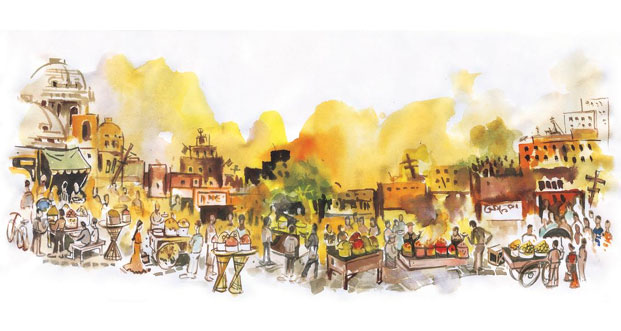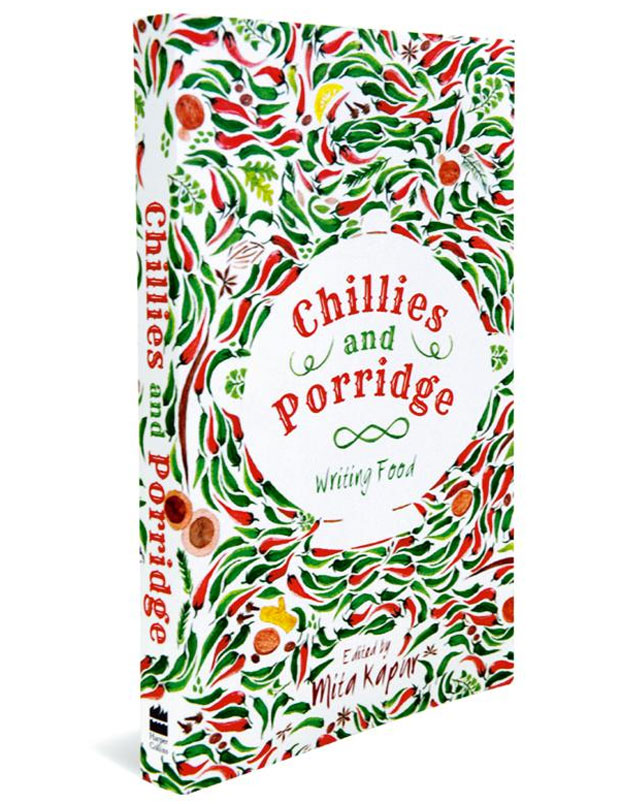
At Brigade Ground, the buses had started to come in from mid-morning; by afternoon, there was a thick, orderly mass of people from Bengal’s districts and villages, streaming in for one of the many rallies held by Mamata Banerjee, the West Bengal chief minister.
Political rallies and bandhs had punctuated the daily life of citizens in Calcutta for so long that it was only the foreigners in our hotel who found it strange that half the city would shut down, the traffic funnelled off the roads or slowing to a crawl, until 5pm. I had grown up in Calcutta, but lived away from the city long enough to be curious about the rally itself. It was a short walk away from the hotel, the crowds pressing in but friendly enough, and as I passed the Victoria Memorial, I began to notice the changing landscape of street food.
That part of Calcutta had always been famous for its phuchkas, the East’s answer to the North Indian golgappa. Chola vendors, bhelpuri and jhaal muri vendors selling variations on spiced mixtures of puffed rice or various green and brown grams were common enough.
But what sprang into view, because of the sheer number of hawker’s stands that had sprung up to service the crowd, was the other kind of street food, so everyday that it barely registered to the Indian eye and that most food writers and historians didn’t consider worth noting—vendors who sold utilitarian, cheap and often nutritious meals.
A rapid survey demonstrated the range of snacks or full meals that you could buy for under Rs.20, sometimes even under Rs.10: litti-chokka, plates of red rice and watery dal, thick rotis made from mixed grains with several variations on ragi, basic khichdis, spicy omelettes (among the most expensive dishes) with the cheapest sliced white bread, thin gruels with fermented rice as the base, and from different districts variations on the sattu.
There was a separation between these hawkers and the vendors who sold the more familiar street foods of Calcutta melas—fat, frilled, oily ‘kabiraji’ cutlets and Mughlai porotas, spiced aloo doms—potato curry accompanied by luchis (made from white flour) or radha ballabi, luchis stuffed with peas, or dalpuri, luchis stuffed with a paste of ground and fried spiced lentils, assorted pakoras and bhaajis, and the familiar range of sticky, syrupy sweetmeats.
The latter were patronized by locals from Calcutta, for whom Mamata’s rally was another excuse to come out on a winter’s day and stuff their faces. The prices of these dishes were not high at all by restaurant standards, but they were not Rs.10 or Rs.15 either. The former had an eye on customers who had come in for the rally without their own food bundles, who were looking for a cheap but filling meal.

The same separation was apparent in so many other Indian cities. When we spoke of ‘street food’, we meant the wide range of savoury and sweet delicacies every Indian city boasted of, from dosas, idlis and buttermilk to golgappas, bhelpuri and papri chaat, from bread pakoras to bedmi aloo. But the rickshaw-pullers who hung around Humayun’s Tomb in Nizamuddin or waited for fares in Chandni Chowk in Old Delhi rarely ate from the chaatwaalas or the jalebiwaalas; even when priced within reach, these foods were not sufficient for a working man’s meal.
They patronized the small stalls that sold home food on the street, sometimes meals as simple as leftover rice fermented through the night and warmed up with a little green chilli and oil, sometimes rotis with one mixed vegetable curry, often grains that the affluent middle classes had abandoned in the pursuit of white flour—a rise in the price of ragi (millet) was far more catastrophic for labourers and rickshaw-pullers than a rise in the price of potatoes. A glass of sattu or a blended ragi drink provides more energy than a plate of rotis and potato curry, and it is much cheaper; where ragi is available, it is often the preferred meal.
But it is hard to see what is right under your nose. In the popular descriptions of Indian food, the distinctions between home and restaurant food are sometimes discussed but it is not so easy to look at what we mean when we say ‘Indian food’, and what we leave out or skate over. Many years ago, travelling in Sikkim, I’d been struck by the cheap tsampa, roasted barley flour, and the ease with which it could be mixed with nothing more exotic than water to make a filling meal that would take you through the high altitudes of Gurudongmar or Yumthang.
But when Sikkimese food is described, it is the momos, delicious pork dumplings served with soup, or thukpa, a thick broth of meat and vegetables served with tiny and delectable variations all the way from Sikkim to Darjeeling to Nepal. Tsampa is too everyday, too monotone, too commonplace to be described, and perhaps it is too much the food of the masses as well.
Yet, everywhere you look, in almost every Indian state, there is some variation on the tsampa and the sattu, and in their ubiquity these mixes are probably as well known, if not better known, than chapattis, rotis and naans. When I read Anjali Purohit’s Ragi-Ragini, a quirky collection of ragi recipes, songs and rhymes that accompanied women’s work in the kitchen and stories around this humble grain, I began to understand how the twin binaries of rice and wheat should not be the default setting in modern Indian households.
Recipes using ragi (also known as nachni or finger millet) are scattered through the book—savoury and sweet porridges, different kinds of sweetmeats—and linked with Bahinabai’s poems and the narrator’s sharing of the histories of the women in her family. The omnipresence of ragi reminded me of how Delhi’s older households almost always served bajra rotis, not wheat flour rotis, in a previous generation. A year or so after reading Purohit’s book and experimenting with ragi recipes, I came across very fancily packaged boxes of finger millet in an organic food store, reinventing the old, almost forgotten, recipes for a new generation that liked the idea of eating healthy….

The question of what an Indian thali is and what doesn’t make it to that plate could have far more disturbing overtones though. Many Indians who are not from the Northeast, for instance, carry their general ignorance of that region to the foods of the Seven Sisters. The distinctions between Nagaland’s cuisine, the subtle differences between Khasi and Garo cooking, the pleasures of a Mizoram feast or an Arunachal-style pickle are lost on the mainland, who often see all of these layered and separate cuisines as foreign.
Yet, in terms of flavour, the distance should not have been that great: the full-bodied aroma of anishi—fermented Colocasia leaves ground with chilli—and other spices used extensively by the Ao Naga tribe and the heavy richness of asafoetida (commonly used in Benares cooking) are not that far apart; the fire of Bhut Jolakia, the famous chilli ubiquitous across Assam, Nagaland and Manipur, is a close cousin to the bite of Andhra chillies.
But at wedding banquets in Delhi’s increasingly lavish nuptial celebrations, there are some troubling omissions: you might find counters of Thai food, or of Chinese food, but rarely would there be a Nagaland counter serving anishi or akhuni, and the containers brimming over with biryani from Lucknow or Hyderabad or even the Syrian Christian style would almost never have a Khasi jadoh rice served with tungtap, a dried fish pickle.
Some of this has to do with meat taboos (chicken is the ‘safe’ meat of India, given the number of communities that object to pork, beef or even have a distaste for goat meat), but much of this also has to do with a deliberate invisibility. The lack of exposure to food from the Northeast is only matched by the lack of mainland Indians’ interest in finding out that these cuisines—which have lasted for centuries—go well beyond momos.
In personal histories from the Dalit community, the most painful of memories, and the most chequered of experiences, concern food. And many also raise a blunt question: why aren’t the staples of the Dalit kitchen Indian enough to feature in mainstream discussions of ‘our’ food? From the segregation of glasses and plates to the feeding of leftovers, food has historically been a way to exercise control, a constant reminder of caste lines. But Dalit food is also secretly coveted, and along with other non-Brahminical communities, the freedom to eat all kinds of meat is often envied.
“They were unusual because they were so humble—red spinach, wild ‘chekor saag’, and what used to be called ‘jungli lahsun’ or wild garlic… “
alongside kale and endive, and packaging them in the way many supermarkets were packaging rocket and mesclun—in large, loose plastic bags. He drew immediate interest from Korean and Chinese shoppers whose assessment of greens was fairly sophisticated, then from other expats who liked the idea of cooking with ‘local Indian stir-fry greens’, and then from a few Indians who remembered the mixed saags and sabzis of their childhood.
It took some research to understand why these greens had disappeared from the market and from many people’s memories. Foraging for plants that are often classified as weeds, but have a high nutritional value is retained in some communities. In a key paper, Sundriyal and Sundriyal document the survival of the practice of harvesting edible wild plants across Sikkim, for example. The Gujjar tribes in Jammu and Kashmir, the millions of tribals in Rajasthan, Chattisgarh and across the Himalayas keep alive the practice of gathering these plants.
But in more urban settlements, the idea of harvesting wild plants has all but disappeared as spaces in cities have shrunk. If the wild ‘commons’ is replaced in small towns and cities with markets, malls and parks, people’s relationship with the land inevitably changes. It takes just one generation of forgetfulness to lose the habit of foraging, though it is now becoming fashionable again in the rest of the world, thanks to the prominence of restaurants like Rene Redzepi’s Noma in Copenhagen. Redzepi, one of the world’s best-known chefs, explained the pull of foraging in an online interview: ‘In a very basic sense, you’re connected to your place—that’s what foraging gives you. You understand what’s edible and you start seeing nature… also as a very delicious resource.’
A few communities still forage—mostly tribals—but there is a fine commonality between tribes as distinct and sometimes as geographically far-flung as the Santhal, Sounti, Gond, Juang, Kol, Bhumiz, Oraon, Munda, Kharwar and Chero. Many forage for the same leaves and plants—pittha sag might be called kointho in a different part of the country, pok arkha might reappear as chimti saag—but the method of collection remains the same: these nutritious plants grow not just in the wild, but in urban and rural ditches, and often in the rows between cultivated plants in tilled fields.
From the point of view of farmers, and also tribals and often Dalit communities, cultivators of fields are either wasteful or blind: the surprise that people would throw away or not notice edible, tasty and nutritious plants echoes from Punjab to Bihar to Assam, if you talk to local foragers.
It is growing harder and harder for me to nail down ‘Indian food’ in any way. Some of the not-seeing is common to those who live in cities and have lost touch with the seasons of growing, or do not know the alphabet of edible plants (or insects and small molluscs, for that matter).
Some of the food that is never talked of as ‘Indian’ is excluded because of deep, and disturbing, biases in favour of the mainland and the mainstream; in some cases, for both vegetarian and non-vegetarian, community taboos mask larger insecurities, angers and fears. And when you begin to add in the food and plant varieties brought in by travellers who came and settled here, asking what ‘authentic’ Indian food might be feels like an absurd project: authentic in which century, for which community?
But some day, perhaps someone will write a history of unseen or overlooked or secret Indian food, spending time with the migrants, the foragers, the cooks excluded by either Brahminical or regional bias. It would have to be a very capacious history, but it would also be a very tasty one.
Excerpted from Chillies And Porridge: Writing Food, edited by Mita Kapur, with permission from HarperCollins India. The book was released on 9 November 2015.
Published first on Live Mint